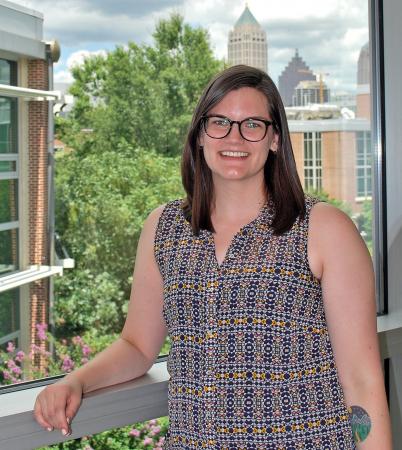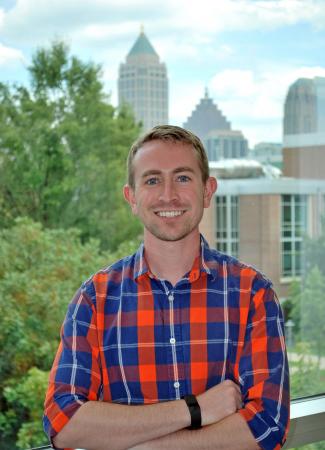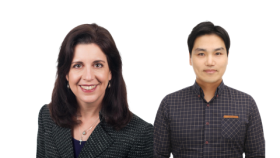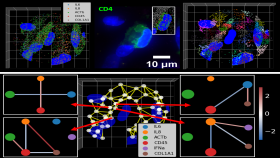After a few years of grad school at the Georgia Institute of Technology, working toward his Ph.D. in biomedical engineering, it dawned on John Nicosia: He could not envision a future for himself in a traditional academic role.
“But there weren’t a lot of resources to explore other ideas,” says Nicosia. “I knew people were doing cool stuff out there, but didn’t really have a sense of what other careers would be available to me.”
Nicosia, beginning his fourth year in the Wallace H. Coulter Department of Biomedical Engineering (a collaboration of Georgia Tech and Emory University), still doesn’t know what he wants to do with the rest of his life, but now he feels like he has more options, and he has the Atlanta BEST program to thank for that.
BEST (Broadening Experiences in Scientific Training) is a National Institutes of Health (NIH) funded program for biomedical-related Ph.D. students and postdocs who want to explore career options.
Several years ago, the NIH became concerned that the long training time combined with a declining percentage of Ph.D. graduates obtaining academic positions would make biomedical research a less attractive career.
“Historically, after your Ph.D. you got a postdoc position, then you became a faculty member somewhere, and that was it,” says Tamara Hutto, the Atlanta BEST program manager. “But now we are graduating way more Ph.D.s than there are faculty jobs available. Faculty positions just aren’t opening up fast enough. Also, our trainees have a wide variety of interests and skills that add value and are critical to sustaining the broader biomedical ecosystem here in the U.S.”
The BEST program was launched in 2013 to experiment with programming and initiatives on a variety of campuses around the U.S. to figure out ways to enhance PhD training preparation and opportunities for the current and future biomedical workforce. The Emory/Georgia Tech partnership was among the first 10 recipients of the NIH BEST awards (later, NIH funded more institutions so that there are now 17 awardees that comprise the NIH BEST Consortium).
The Atlanta BEST program has several aims:
• Expose trainees to a broad variety of career pathways and career development approaches.
• Provide trainees deep immersion in a specific career pathway beyond academic science.
• Better equip faculty at Emory and Georgia Tech to support and train grad students and postdoctoral fellows for the 21st century workforce.
Ultimately, NIH wants to identify best practices developed through the BEST Consortium and disseminate them to other institutions.
One cohort of 20 to 30 trainees per year is admitted into the Atlanta BEST program. The fourth cohort begins this fall. Trainees spend two years in the program, during which they go through a series of workshops and experiences that include:
• A variety of self-assessments to determine an individual’s interests, bringing awareness to preferred work environments and styles.
• Hands-on, practical career and professional development workshops.
• Exploration of career options through speakers, networking, informational interviews, resources, BEST staff and faculty, and part-time internships.
• Leadership training, with a nod toward communication skills, team building, peer mentoring, emotional intelligence, and conflict management.
• A commercialization series to learn the basics of patent and business law, and technology transfer.
“What we’re learning is, there is no one size fits all – what works at Georgia Tech may not work at Emory, and vice versa. Also, what works for one trainee, may not work for another,” Hutto says. “So we’re trying a lot of different things and tweaking them as we talk with, and get feedback from, trainees and faculty on both campuses.”
The one component that is working very well across the board, according to Hutto, is the cohort model, “because it means the trainees are working with each other, building community, mentoring their peers.”
Georgia Tech student Alyson Colin is particularly interested in that mentoring part, and sees herself as a good resource for her lab group (she works in the lab of Amit Reddi, researcher in the Petit Institute for Bioengineering and Bioscience and assistant professor the School of Chemistry and Biochemistry).
“Hopefully I can use what I’ve learned and pass it on to my colleagues, friends, and other graduate students in the program,” says Colin, in her fourth year pursuing a Ph.D. in Chemistry and Biochemistry.
Colin feels well prepared for work as an academic researcher. If only that was her career choice. She was the first grad student to join Reddi’s lab after he arrived at Georgia Tech and set up shop.
“I have a good idea of what it takes to start up a lab by seeing, first hand, the sacrifices and dedication it takes,” she says. “I feel like the Ph.D. experience gives us a clear picture of how to build a career in academia. But I want to discover what the industry and government sectors look like.”
After three years as a Ph.D. student and now with exposure to the BEST program, Colin says her dream job would be, “something like 25 percent research and 75 percent outreach and communication.”
She likes sharing what she’s learned and sees a future in which she prefers lectures to labs, so she’s pursued a variety of teaching assistant opportunities and volunteers at the Georgia Aquarium, “where I can interact with the public and tell them cool things about chemistry, such as how a sea anemone stings you. I find that I’m the happiest when I’m communicating and discussing science. I love sharing my enthusiasm with others and seeing their light bulbs come on.”
Nicosia is also interested in the communication part of the equation.
“I really like writing, and the challenge of communicating effectively with both peers and a lay audience,” says Nicosia, who works in the lab of Petit Institute researcher Wilbur Lam, assistant professor of pediatrics and biomedical engineering in the Coulter Department. “There’s a whole breadth of career options in that area, communicating science to the general public, medical and science writing, even interpreting research to members of Congress and other policy makers.”
He’s also developed a growing interest in technology transfer and is even considering a job that previously never occurred to him: medical science liaison, the person in a medical device or pharmaceutical company who establishes peer-peer relationships with physicians, “the people who are actually using the products,” says Nicosia, who has developed better career clarity.
“I feel like I’ve broadened my horizons,” he says. “Like I’ve got more agency now regarding my career decisions.”
CONTACT:
Jerry Grillo
Communications Officer II
Parker H. Petit Institute for
Bioengineering and Bioscience
Media Contact
Jerry Grillo
Communications Officer II
Parker H. Petit Institute for
Bioengineering and Bioscience
Keywords
Latest BME News
Courses in the Wallace H. Coulter Department of Biomedical Engineering are being reformatted to incorporate AI and machine learning so students are prepared for a data-driven biotech sector.
Influenced by her mother's journey in engineering, Sriya Surapaneni hopes to inspire other young women in the field.
Coulter BME Professor Earns Tenure, Eyes Future of Innovation in Health and Medicine
The grant will fund the development of cutting-edge technology that could detect colorectal cancer through a simple breath test
The surgical support device landed Coulter BME its 4th consecutive win for the College of Engineering competition.
New research from Georgia Tech helps doctors predict how therapies will interact with a child's immune system, potentially improving outcomes and reducing risks.
Georgia Tech researchers reveal the dynamic role of inhibitory neurons in spatial memory and learning









